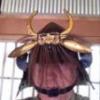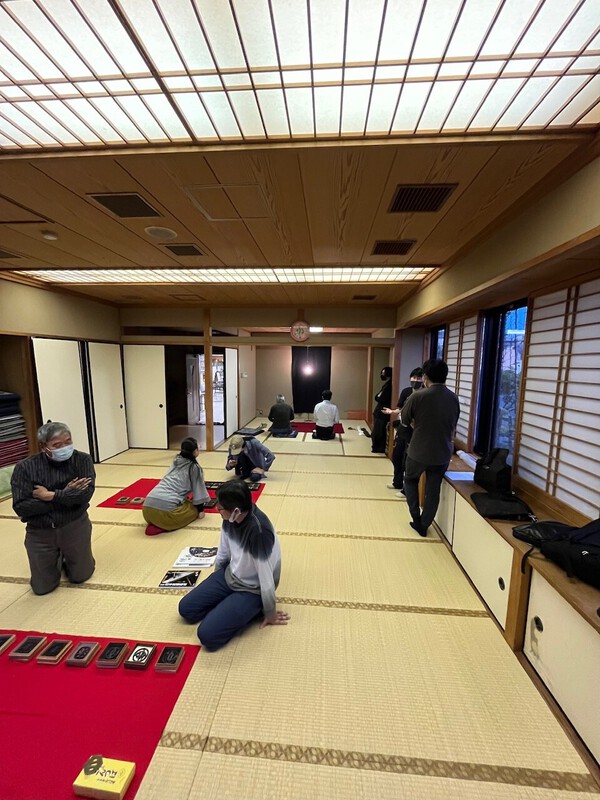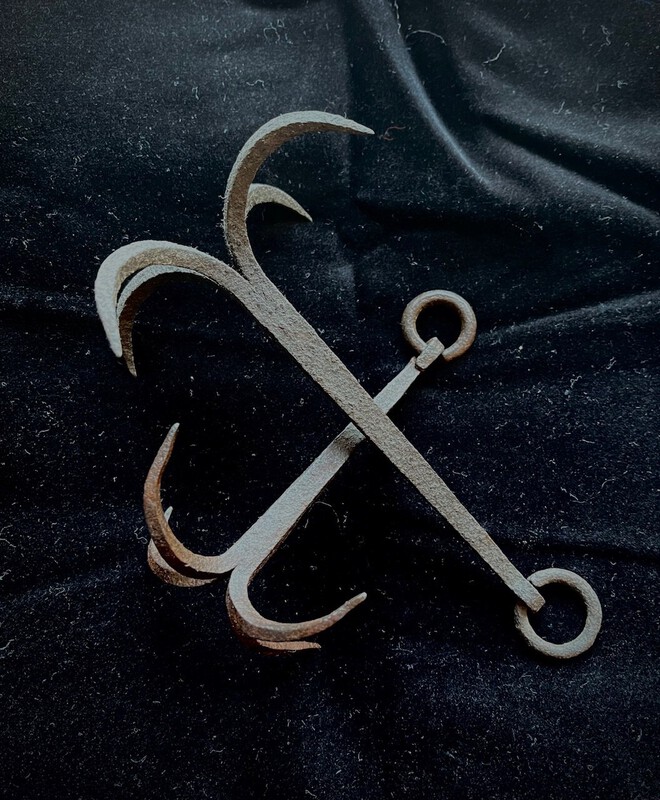-
Posts
12,563 -
Joined
-
Last visited
-
Days Won
201
Content Type
Profiles
Forums
Events
Store
Downloads
Gallery
Everything posted by Bugyotsuji
-

Edo Period Corner Part II
Bugyotsuji replied to estcrh's topic in General Nihonto Related Discussion
Chris in Indiana posted a thread on his incredible ken collection recently, and that triggered my hand to start a new project. A mumei ken in pretty terrible condition turned up at auction and I overstretched myself to snag it. The whole thing is a bag of bones, but since some of us are in the resurrection business, I plan a restoration attempt. It's registered as a 古剣, but under the rust it could be anything. This one will almost definitely not get me my money back. It'll need a koshirae rebuild, a shirasaya, and a full togi polish. "Some sucker went and bit the bullet!" Sadly it's another of these dang gambles, having bought on an impulse, again.... aaarrrrgggghhhh. When I say 'bought', I should add 'on credit' as I didn't even have the cash to cover it. I've got till next Monday to stand on the street corner and whistle Dixie. -

Edo Period Corner Part II
Bugyotsuji replied to estcrh's topic in General Nihonto Related Discussion
The ones on the right side each showed some vital aspect of the old tsuba areas; they all belonged to our sword appreciation Sensei. There was another top quality collection on the other felt cloth in the background. (Those on the left were my contribution to the evening.) -

Translation of Hozon paper text parts?
Bugyotsuji replied to Andi B.'s topic in Translation Assistance
Yes, those are the other characters for Tsukushi. Sometimes there are two or three (sets of) Kanji characters for writing the same word! PS They are eatable as you say but whether they are edible is another question! -

Edo Period Corner Part II
Bugyotsuji replied to estcrh's topic in General Nihonto Related Discussion
Last night among the blades for appreciation at the local NBTHK sword meet we had a beautiful wakizashi by Hizen Tadayoshi (Tadahiro). It once belonged to a senior member of another local branch just west of here. The story was interesting. Mumei, the brushwriting on the saya certified that it was an exceptional work by the first generation Tadayoshi. Since there was no doubt in anyone's minds, the previous owner had a Mei added to the nakago, and sent it off for NBTHK shinsa. It came back 'gimei'. So, the present owner had the fake signature professionally erased and then sent it back to shinsa. It came back certified to Tadahiro/Tadayoshi. He grinned as he showed me the shirasaya, which still proclaims in old brushwork: 'Hizen Tadayoshi'. (Listening with one ear. Hoping I've got the details of this straight!) -

Translation of Hozon paper text parts?
Bugyotsuji replied to Andi B.'s topic in Translation Assistance
Great link btw. Not seen that before. PS Mauro, it’s Kobushi not Kobishi! -

Translation of Hozon paper text parts?
Bugyotsuji replied to Andi B.'s topic in Translation Assistance
My wife picks them Andi and (thinks she) knows how to prepare them for cooking. I was reluctant, but asked her if they were delicious. “No, not really,” she replied, “but they are a sign of spring so it’s important to make the effort to have them once at least.” -

Translation of Hozon paper text parts?
Bugyotsuji replied to Andi B.'s topic in Translation Assistance
土筆 Tsukushi are horsetails, but it’s unfair to expect anyone to know this without a pic of the object itself. 据紋 Suemon usually indicates an applied mon or symbol of some kind, often in metal. Zōgan are inlays Iro-é are depictive images often in colo(u)r -

gunto "hopefully got it right this time" translation
Bugyotsuji replied to lonely panet's topic in Translation Assistance
Well done, Hamish! (What phone are you using?) -
On the top left is the kiln name Gingetsu, plus 造 (make). The other is the same style but.... a different kiln name, Senshu, plus 造. Of the two, the top Shimadzu crest is quite casually done. Otherwise they are so similar stylistically that they could easily be individual artisan or kiln master names.
-
The maedate idea is definitely a good thought, Damon! For the upper and lower symbols, however, as a design element, the 丙 hei fishtail of the old counting sytem of 甲、乙、丙 also seems possible. In fact I think some karimata are somehow based on hei. Hei is related to hasso, the correct braced stance for a sword-wielding Bushi to place the feet, also seen in the design of Tanegashima butts.
-
Thought long and hard about this same tsuba yesterday or the day before. The single elements north and south remind me of karimata arrowheads. The side elements remind me of Sanscrit characters, called Bonji in Japan. Does that help get the ball rolling?
-
Thanks for the closer surface shots, Jens.
-
Quick off-topic warning! We have John C. x2 here, but regarding the picturesque fishing village of Tomo-no-Ura, to John C. 2, it's a great place to visit if you are ever down Fukuyama way. Also, Miyazaki Hayao rented a house there with a stunning view while he was working on the animation Ponyo. Ponyo - Wikipedia Apologies to John C. 1
-
'Mokume' means a wood grain (with swirls, whorls) pattern. 'gane is a form of 金, かね, kane, which is essentially metal but here indicates iron or steel. For me, there is not a lot of information to be had from this tsuba. It's a thick forged circular iron plate with 'sukashi' openings depicting river flow and a water fowl, a single wild goose? There were many marshes between Kyoto and Osaka. This kind of thicker tsuba suggests later rather than earlier work, so we might well be looking at the Edo Period. The surface looks a bit rough. Was it once lacquered, or has it been in a fire, with subsequent rust? Lots to speculate about, but little concrete. The above is my feeling only and open to adjustment by our regular tsuba experts here!
-

Cross-References to Observed Tanegashimas
Bugyotsuji replied to Kiipu's topic in Tanegashima / Teppo / Hinawajū
Thanks, Thomas. I spent several hours here yesterday answering that to the best of my ability. (Good excuse to avoid doing some serious work hanging over me though.... aaaarrrrgggghhhhh......) Tanegashima Help - Tanegashima / Teppo / Hinawajū - Nihonto Message Board (militaria.co.za) -

Forgotten Weapons does tanegashima.
Bugyotsuji replied to Geraint's topic in Tanegashima / Teppo / Hinawajū
Better than I expected. A few bloopers in that video, but generally a surprisingly good grasp. -

Naminohira Yasumasa wakizashi in very nice koshirae
Bugyotsuji replied to Ray Singer's topic in Swords and Edged Weapons
Cool, message self-destructing! -

Naminohira Yasumasa wakizashi in very nice koshirae
Bugyotsuji replied to Ray Singer's topic in Swords and Edged Weapons
Naminohira, we like! Also the koshirae… -
Out of curiosity I worked through 1,000 Kunitomo smiths today looking for a last name with that Kanji, but found none. Another long shot was Kunitomo locksmiths, and here I struck a possibility. In the Bunka~Tempo period there was a locksmith called 田中・又四郎, (Tanaka Matajirou)and it is quite possible that people called him 又 'Mata' for short. That could strengthen the reading of the mark in your brass lockplate. (Assuming of course that this is a Kunitomo gun, which is not yet proven.) See some of these examples of how to write a 'Mata' in squiggle form. 「又」(U+53C8) | 日本古典籍くずし字データセット (rois.ac.jp)
-
Yes, I showed one I had to some sword polishers and they agreed that none of them would like to attempt such a polish. Not directly related, but like Alex above, the idea of splitting out a central steel rod reminded me of well-bucket hooks or anchors. These are sometimes called Ninja hooks, with three or four curled barbs for throwing up onto walls etc. on the end of a rope. I heard that genuine old examples are of one piece, peeled out from a central shaft.
-
Ah, thanks. Yes, that upright piece of metal is called the Ibo-kakushi, or screen to hide the protruding tongue. The hole in that one is purely decorative. Your trigger also has a decorative hole in it. These ibo-kakushi came in several shapes and sizes and styles, and can often indicate the gun's place of manufacture. This is one of the reasons I suggested Kunitomo, as I have seen square ones with a forwards slant like yours from there, but it is not really definitive enough. Bizen and Awa guns also had a similar shape with a central hole, but your gun does not have any other supporting features of Bizen or Awa. PS Looks like the pan lid/cover hinge pin is blocked with dirt. These pins were hollow internally from the top down , so it's ok to clean it out. PPS Kunitomo had a reputation to keep as the Tokugawa placed their orders there. It has been said that one of the distinguishing features of Kunitomo is a lack of any features, meaning that they could produce anything for any customer.
-

Edo Period Corner Part II
Bugyotsuji replied to estcrh's topic in General Nihonto Related Discussion
Yes Alex, like katana, wakizashi and tanto 短刀! All sizes and uses, but all smoothbore. Tanzutsu 短筒 were really for a holster, a shorter pistol to be fired in the standing position. Bajozutsu 馬上筒 were longer, like slightly shorter long guns, equestrian, for ease of loading on horseback. These might be referred to as a carbine in the West. There were long thin guns for target shooting and small game, heavier army guns, even heavier Samurai guns, and then a series of serious 大筒 O-zutsu hand cannons. In the display was a three-barrel matchlock; these were heavy, so naturally they were built shorter. -

Edo Period Corner Part II
Bugyotsuji replied to estcrh's topic in General Nihonto Related Discussion
This is true, Alex. There is an average of one Tanegashima matchlock at most of the arms fairs I've been to in the UK. (= a rough average of none or two.) Occasionally there will be a really fine example, though. Our leader was in hospital and it seemed that he had ordered me to organize the display. I decided to concentrate on Bizen guns as they were produced in the area, and this shrine is dedicated to the Ikeda Daimyo. It seemed a Golden Opportunity to finally get everyone to show their Bizen guns in public, as something to be proud of. I was getting ready a list of Bizen gunsmiths, and a worksheet on the late Edo swordsmith who was tasked with creating a gunsmithing community in Osafune. Later I learned that he had also asked others to bring examples, but his brain always works on the pattern of educating the public about Tanegashima in general. So I thought, great, there will be some tables with the rare or unusual guns and then others for a dedicated Bizen section. Then he came out of hospital and started changing everything back again. Well, he is the big boss, so I altered all my plans to fall in line. He put me at the end of the display with his request for matchlock accessories, so I kept it minimal, but mixed in three Bizen guns to flesh it out. -
Ah, thanks. That diameter gives a 3.5 Monme ~ 4 Monme ball, which tips this gun into the military range category (as opposed to small game or target shooting). Sometimes the Bisen gets twisted and snapped in two when someone is trying to force one open. It's irritating to discover, but not the end of the world. Glad to you have someoe to drill it out. I am sure you are aware, but just make sure that the tip of the new breech screw does not go so far as to block the internal end of the vent passage. You mention a 'hole'? I was referring not to the leaf spring, but to the butt end of the external side lock plate. They are most often squared off, but you get different regional or gunnery school shaped endings. Yours though unusually has the left lower corner cut diagonally. (I am wondering if your gun might not be from Kunitomo.)
-
My kinko book lists a Myochin Katsuharu/Katsuji from Echizen from around the Genroku era. Sasama (p.57) however in his armor book says that Myochin (かつはる) Katsuharu was from the end of Edo, living in Fukui, devoted to making tsuba because the market for katchu had dried up. I had a somewhat similar tsuba, (quite thick, right?), unsigned, but sadly I think I sold it.









